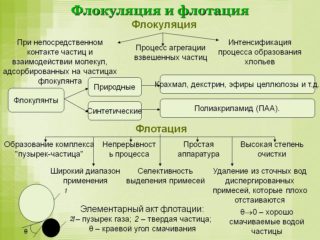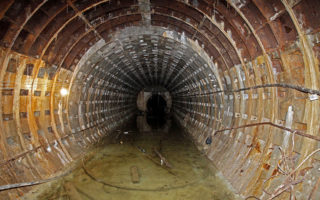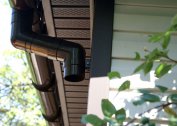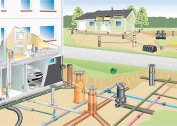Used water from the sink, toilet bowl, bathtub, household appliances goes into the sewer. All human waste in the amount of approximately 100-200 liters per day. Wastes go through several stages of treatment and are discharged into a reservoir.
What happens to drain drains after getting into the sewer
The first receiver of domestic wastewater from each apartment is a sewer pipe. Further, the water along the common house riser goes into the city collector. The diameter of the pipeline here is large enough to accommodate an average of 2 million m3 of sewage per day. Often the city highway has a diameter of 70 cm or more.
Along the way, household polluted water is combined in the city sewer with storm water. They are transported either by gravity with a favorable terrain and created slope, or continue to go along the collector with the help of powerful pumps.
All collected wastewater flows into the sewer pools in the districts and then sent to the treatment plant. She, as a rule, is satisfied outside the boundaries of the village. It is not a matter of sharp specific smells, but of the whole enterprise. The station covers an area of up to several km2.
The length of the city collector depends on the size of the settlement and can be more than 5,000 km in total (for cities with a population of over one million).
The municipal sewage system does not accept effluents from industrial enterprises. These contaminated waters have their own treatment systems.
Wastewater Treatment Methods
 Local sewage treatment plants look like huge pools in a complex with closed tanks. Purification and clarification of effluents here occurs in stages. The process is constantly monitored by the employees of the enterprise. If the slightest failure occurs on VOC, this threatens the city with an environmental disaster.
Local sewage treatment plants look like huge pools in a complex with closed tanks. Purification and clarification of effluents here occurs in stages. The process is constantly monitored by the employees of the enterprise. If the slightest failure occurs on VOC, this threatens the city with an environmental disaster.
Sewerage care in cities and further wastewater treatment are carried out by two main methods - mechanical and biological. Moreover, in strict sequence.
Additional methods are considered for the disinfection of clarified liquids before they are discharged into open water bodies.
Mechanical cleaning
 The main stage of effluent clarification is mechanical. First, water in huge volumes continuously flows through large-diameter pipes into the first receivers. During the day, its volume is greater, at night - less. Sewage contains third-party garbage, impurities of feces. Cloth, personal hygiene items, paper, small accessories, food waste in the form of tea bags, etc. are often found in water. All this must be removed from contaminated drains. To do this, use a special lattice through which only dirty water with small dissolved particles of feces passes. The rest of the trash settles on the grates.
The main stage of effluent clarification is mechanical. First, water in huge volumes continuously flows through large-diameter pipes into the first receivers. During the day, its volume is greater, at night - less. Sewage contains third-party garbage, impurities of feces. Cloth, personal hygiene items, paper, small accessories, food waste in the form of tea bags, etc. are often found in water. All this must be removed from contaminated drains. To do this, use a special lattice through which only dirty water with small dissolved particles of feces passes. The rest of the trash settles on the grates.
The next stage of mechanical cleaning is grease traps. They remove all oily impurities, because bacteria can not cope with such contaminants. Water continues to flow through them in a continuous stream.
Sewage flows at high speed through a sand trap basin. The bottom of such a reservoir is conical. Heavy particles of sand, earth in water settle in it. They fall into drains along with storm water or from household sewers after floor cleaning.
Biological treatment
 This method of wastewater treatment makes it possible to turn contaminated water into relatively clean water and helps to produce organics suitable for further compost production. Thermal energy and gas are obtained from sewage treated with bacteria. A similar cleaning method was proposed by the British in 1913.
This method of wastewater treatment makes it possible to turn contaminated water into relatively clean water and helps to produce organics suitable for further compost production. Thermal energy and gas are obtained from sewage treated with bacteria. A similar cleaning method was proposed by the British in 1913.
Organic impurities in drains are good food for a certain kind of bacteria. Microorganisms process fecal matter, turning them into organic sludge and simultaneously reducing in volume.
Aerobic and anaerobic bacteria are used for biological wastewater treatment. The first work on condition that oxygen is supplied to the sewage tank. The second - actively act without oxygen at the very bottom of the aeration tank. The same process occurs in the soil, resulting in fertilizer compost.
During biological treatment, wastewater enters the aeration tank (sealed tank). Bacteria in the form of activated sludge are loaded into it and they constantly maintain a certain temperature and oxygen supply. If you observe the process from the side, clearly visible moderately powerful seething. This is the process of decomposing sewage into carbon dioxide and water. Due to the continuous supply of oxygen, organic sludge does not settle to the bottom of the aeration tank, but is constantly in contact with organic matter (fecal matter). The entire clarification process takes from 8 to 10 hours.
The resulting precipitate in the form of organic sludge is squeezed through a centrifuge and sent to production for compost. The clarified water goes to the next tank for tertiary treatment.
During the work of anaerobic bacteria, methane gas is released. It is used to generate thermal energy.
 If necessary, clarified waters are additionally treated with physicochemical methods:
If necessary, clarified waters are additionally treated with physicochemical methods:
- flotation;
- coagulation;
- adsorption;
- extraction;
- reverse osmosis;
- dialysis;
- electrocoagulation, etc.
Each of them is selected depending on the composition of the effluents purified by the bacterial method.
Where is treated wastewater discharged?
Lastly, the water goes through a post-treatment process. Here, clarified wastewater is passed through a fine sieve cloth to trap the remaining debris. Then the entire volume of water is sent to the outlet channel of the treatment plant. In this place, a unit for disinfecting wastewater with ultraviolet radiation is installed.
The idea of the final chlorination of water before discharge was previously put forward. But this method of purification was abandoned, since chlorine causes irreparable harm to the environment. All living things in water bodies after the discharge of clarified water would simply perish.
The completely purified and ultraviolet-disinfected wastewater is discharged into a nearby body of water. In most cases, these are local rivers. In resort towns - the sea. Water is supplied to natural reservoirs through deep pipes so as not to disturb the microclimate in the source.
The level of discharge of treated effluents is at a depth of 4-17 meters. Such water does not cause harm to the underwater world. Its sanitary indicators are many times higher than the river / sea environment. Such water can be used for domestic purposes. For eating, it is better to boil it.



